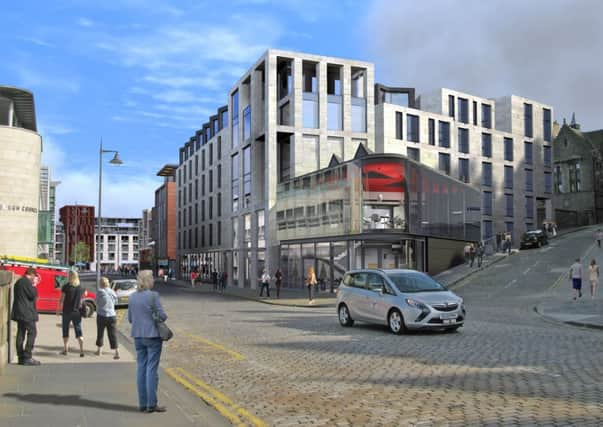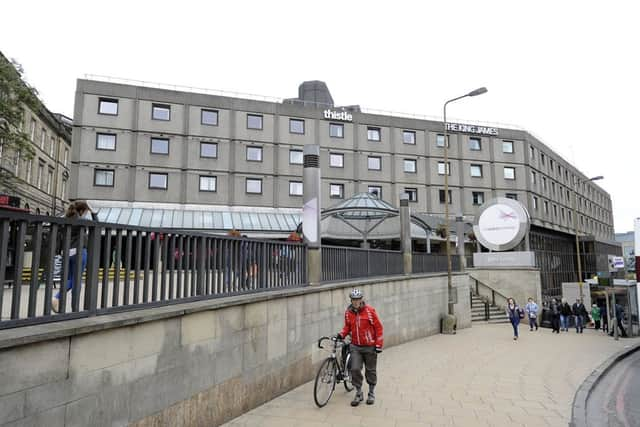Academic blasts Edinburgh’s modern buildings


Professor Richard Williams says the evolution of the city’s landscape has been “clouded by a sense of failure or worse” since the mid-19th century.
And he has raised concerns that new schemes such as Caltongate, the controversial development recently approved for a site next to Waverley Station, risk ‘desecrating’ the city’s world heritage status.
Advertisement
Hide AdAdvertisement
Hide AdProfessor Williams, who was born in Washington but grew up in Manchester, also condemned Edinburgh for the “gloomy, down-at-heel character” of its shopping streets, claiming they are dominated by charity shops.


He said there was now little evidence of the “rivers of money” that flowed through Edinburgh in the early part of the new century, saying the city was being let down by the “shabby” quality of its infrastructure.
His comments have emerged in separate essays, for Building Design magazine and Times Higher Education, just weeks before the city’s troubled tram project is due to start operating - five years later than planned.
He writes that Edinburgh has suffered “immense reputation damage” over the tram project - the budget of which has more than doubled despite the scheme being dramatically scaled back - which would deter it from instigating major projects in future. But he claims the city has long been inhibited by a culture of “risk-aversion.”
He wrote: “In Edinburgh, the New Town represents the high watermark of architectural achievement and, listening in on recent conversations about development, you could easily come away with the impression that nothing of any consequence has happened since. Almost everything has been clouded by a sense of failure or worse.
“The University of Edinburgh’s rebuilding of the 18th-century George Square in the early 1960s is still, half a century later, widely regarded as a trauma on a par with the Second World War.
“The St James centre at the eastern end of Princes Street, a Brutalist megastructure completed in 1973, is a cause of shame among the city’s chattering classes.
“The development of the Leith Docks is at best a collection of fragments – and will remain so because they will not be connected by tram to the city centre.
Advertisement
Hide AdAdvertisement
Hide Ad“Now another architectural embarrassment seems to be in the making: ‘Caltongate’, a modest mixed-use proposal close to Waverley Station, which many observers think desecrates the Old Town’s Unesco status.
“Foreign visitors I have shown around routinely find themselves dismayed by the shabby quality of the city’s infrastructure and the gloomy, down-at-heel character of shopping streets, many dominated by charity outlets.”
Professor Williams, who was born in Washington but grew up in Manchester, said nothing of the “scale or grandeur” of the Scottish Parliament building at Holyrood has been built since and drew a contrast between Edinburgh and Dublin, which he said “positively crackles with wealth.”
Mr Williams, a professor of contemporary visual cultures at the university, added: Scotland’s economy might be the UK’s most resilient outside the south-east. But walk up any of Edinburgh’s hills and you don’t see much evidence of it. It’s a landscape that has barely changed in a century. Rivers of money flowed through the city in the 2000s, but little of it left a trace.”
Marion Williams, director of the Cockburn Association, the city’s main heritage watchdog, said: “I cannot disagree with him.
“There is a lack of vision, there is no great plan, there is a total lack of ambition, no risks, just rather dull and uninspiring compromise that can hardly be called ‘architecture’.
“We need more home-grown architects, who understand the fantastic grain of the city, involved instead of clients seeking the mundane anywhere-architecture we suffer at the moment.”
However Adam Wilkinson, director of the Edinburgh World Heritage trust, said Professor Williams was not “looking hard enough” for evidence of progress in the city, with major regeneration projects carried out in both the New Town and the Old Town since 1970.
Advertisement
Hide AdAdvertisement
Hide AdHe told The Scotsman: “Every city has its own story. Edinburgh mostly avoided the appalling demolitions that long blighted the communities of the great cities of the UK, be they Birmingham, Glasgow or Manchester. We don’t shout about the city’s successes. Maybe we should.”
City council leader Andrew Burns said: “We know from the number of awards and accolades that we regularly receive the regard in which Edinburgh is held by the millions of people that visit the city each year.
“Edinburgh has proved to be extremely resilient during the economic downturn and, with development getting underway on a number of gap sites across the city – many of which had lain empty for many years – and the launch of the tram service imminent, I think there is every reason to be confident of Edinburgh’s continued prosperity.”
A spokesman for national tourism agency VisitScotland said: “Edinburgh welcomes millions of visitors from all over the world every year, with feedback on the city overwhelmingly positive.
“Our research shows that 97 per cent of visitors to Edinburgh would recommend it to others. Scotland’s capital boasts not only stunning vistas, but also world-class visitor attractions and superb retail experiences.”
Donald Anderson, a former leader of the city council, who led the local authority at the height of the economic boom, said: “Edinburgh has faced many challenges – not least the mismanagement of the tram project, but this is perhaps the most exciting time I can remember for economic and cultural development in the city.
“Despite the aftermath of the longest economic downturn in modern history, the city centre is bouncing back with George Street full and vibrant, Shandwick Place coming alive again and Princes Street seeing renewed investment and vibrancy. Investment and confidence has returned to pre-recession levels, and I genuinely think that an economic renaissance has already begun.
“There are undoubtedly challenges ahead, but Edinburgh faces them in good heart and with great economic strengths from its smart people and stunning cityscape. We should be looking forward and talking the city up, not from fear but from ambition.
“I am convinced that the city’s best days are ahead of it and opportunity, rather than negativity, should be what occupies our minds.”